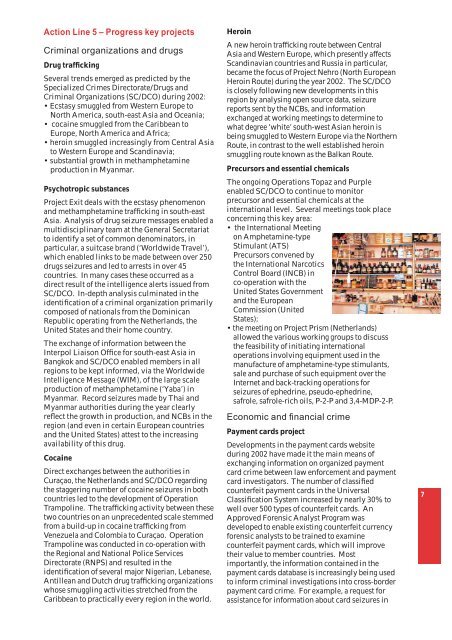Download - Interpol
Download - Interpol
Download - Interpol
You also want an ePaper? Increase the reach of your titles
YUMPU automatically turns print PDFs into web optimized ePapers that Google loves.
Action Line 5 – Progress key projects<br />
Criminal organizations and drugs<br />
Drug trafficking<br />
Several trends emerged as predicted by the<br />
Specialized Crimes Directorate/Drugs and<br />
Criminal Organizations (SC/DCO) during 2002:<br />
• Ecstasy smuggled from Western Europe to<br />
North America, south-east Asia and Oceania;<br />
• cocaine smuggled from the Caribbean to<br />
Europe, North America and Africa;<br />
• heroin smuggled increasingly from Central Asia<br />
to Western Europe and Scandinavia;<br />
• substantial growth in methamphetamine<br />
production in Myanmar.<br />
Psychotropic substances<br />
Project Exit deals with the ecstasy phenomenon<br />
and methamphetamine trafficking in south-east<br />
Asia. Analysis of drug seizure messages enabled a<br />
multidisciplinary team at the General Secretariat<br />
to identify a set of common denominators, in<br />
particular, a suitcase brand (‘Worldwide Travel’),<br />
which enabled links to be made between over 250<br />
drugs seizures and led to arrests in over 45<br />
countries. In many cases these occurred as a<br />
direct result of the intelligence alerts issued from<br />
SC/DCO. In-depth analysis culminated in the<br />
identification of a criminal organization primarily<br />
composed of nationals from the Dominican<br />
Republic operating from the Netherlands, the<br />
United States and their home country.<br />
The exchange of information between the<br />
<strong>Interpol</strong> Liaison Office for south-east Asia in<br />
Bangkok and SC/DCO enabled members in all<br />
regions to be kept informed, via the Worldwide<br />
Intelligence Message (WIM), of the large scale<br />
production of methamphetamine (‘Yaba’) in<br />
Myanmar. Record seizures made by Thai and<br />
Myanmar authorities during the year clearly<br />
reflect the growth in production, and NCBs in the<br />
region (and even in certain European countries<br />
and the United States) attest to the increasing<br />
availability of this drug.<br />
Cocaine<br />
Direct exchanges between the authorities in<br />
Curaçao, the Netherlands and SC/DCO regarding<br />
the staggering number of cocaine seizures in both<br />
countries led to the development of Operation<br />
Trampoline. The trafficking activity between these<br />
two countries on an unprecedented scale stemmed<br />
from a build-up in cocaine trafficking from<br />
Venezuela and Colombia to Curaçao. Operation<br />
Trampoline was conducted in co-operation with<br />
the Regional and National Police Services<br />
Directorate (RNPS) and resulted in the<br />
identification of several major Nigerian, Lebanese,<br />
Antillean and Dutch drug trafficking organizations<br />
whose smuggling activities stretched from the<br />
Caribbean to practically every region in the world.<br />
Heroin<br />
A new heroin trafficking route between Central<br />
Asia and Western Europe, which presently affects<br />
Scandinavian countries and Russia in particular,<br />
became the focus of Project Nehro (North European<br />
Heroin Route) during the year 2002. The SC/DCO<br />
is closely following new developments in this<br />
region by analysing open source data, seizure<br />
reports sent by the NCBs, and information<br />
exchanged at working meetings to determine to<br />
what degree ‘white’ south-west Asian heroin is<br />
being smuggled to Western Europe via the Northern<br />
Route, in contrast to the well established heroin<br />
smuggling route known as the Balkan Route.<br />
Precursors and essential chemicals<br />
The ongoing Operations Topaz and Purple<br />
enabled SC/DCO to continue to monitor<br />
precursor and essential chemicals at the<br />
international level. Several meetings took place<br />
concerning this key area:<br />
• the International Meeting<br />
on Amphetamine-type<br />
Stimulant (ATS)<br />
Precursors convened by<br />
the International Narcotics<br />
Control Board (INCB) in<br />
co-operation with the<br />
United States Government<br />
and the European<br />
Commission (United<br />
States);<br />
• the meeting on Project Prism (Netherlands)<br />
allowed the various working groups to discuss<br />
the feasibility of initiating international<br />
operations involving equipment used in the<br />
manufacture of amphetamine-type stimulants,<br />
sale and purchase of such equipment over the<br />
Internet and back-tracking operations for<br />
seizures of ephedrine, pseudo-ephedrine,<br />
safrole, safrole-rich oils, P-2-P and 3,4-MDP-2-P.<br />
Economic and financial crime<br />
Payment cards project<br />
Developments in the payment cards website<br />
during 2002 have made it the main means of<br />
exchanging information on organized payment<br />
card crime between law enforcement and payment<br />
card investigators. The number of classified<br />
counterfeit payment cards in the Universal<br />
Classification System increased by nearly 30% to<br />
well over 500 types of counterfeit cards. An<br />
Approved Forensic Analyst Program was<br />
developed to enable existing counterfeit currency<br />
forensic analysts to be trained to examine<br />
counterfeit payment cards, which will improve<br />
their value to member countries. Most<br />
importantly, the information contained in the<br />
payment cards database is increasingly being used<br />
to inform criminal investigations into cross-border<br />
payment card crime. For example, a request for<br />
assistance for information about card seizures in<br />
7














